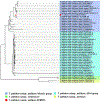A Novel Treponema pallidum Subspecies pallidum Strain Associated With a Painful Oral Lesion Is a Member of a Potentially Emerging Nichols-Related Subgroup
- PMID: 38829929
- PMCID: PMC11542556
- DOI: 10.1097/OLQ.0000000000001971
A Novel Treponema pallidum Subspecies pallidum Strain Associated With a Painful Oral Lesion Is a Member of a Potentially Emerging Nichols-Related Subgroup
Abstract
Background: Early syphilitic lesions are typically painless; however, several recent case studies have included patients with tender lesions and no evidence of concurrent infections. Here we present the manifestations and serological and molecular findings of a patient from New York State with a painful tongue lesion.
Methods: The diagnosis of syphilis was based on a combination of physical examination, serologic, pathologic, and immunohistochemical findings. DNA obtained from a formalin-fixed, paraffin-embedded biopsy was used to characterize the infecting pathogen using polymerase chain reaction, multilocus sequence typing, and whole-genome sequencing methods.
Results: Polymerase chain reaction and multilocus sequence typing of the biopsy specimen confirmed infection with T. pallidum subspecies pallidum ( T. pallidum ) of the Nichols cluster. Whole-genome sequencing analysis of this strain (herein called NYMC01) showed that it contained 17 unique single nucleotide variations and 4 more complex genetic differences; this novel genotype matched only 2 specimens, both from a patient in Seattle, Washington. The presence of this rare genotype in 2 geographically distinct locations suggests the potential emergence and spread of a new subgroup of the Nichols cluster.
Conclusions: To our knowledge, this is the first genomic sequence obtained from a T. pallidum strain linked to a painful lesion, and the third description of whole-genome sequencing of T. pallidum from formalin-fixed, paraffin-embedded tissue. Analysis of additional specimens may reveal that the NYMC01-related genotype represents an emerging T. pallidum subgroup and may also aid in determining whether the painful clinical presentation of primary syphilis is related to specific T. pallidum genotypes.
Copyright © 2024 The Author(s). Published by Wolters Kluwer Health, Inc. on behalf of the American Sexually Transmitted Diseases Association.
Conflict of interest statement
Conflict of Interest and Sources of Funding: The authors declare no conflicts of interest. This research was supported in part by the National Institute of Allergy and Infectious Diseases of the National Institutes of Health under award numbers R01 AI141958 (D.G.E., S.J.N.) and R21 AI171714 (D.G.E.). The content is solely the responsibility of the authors and does not necessarily represent the official views of the National Institutes of Health.
Figures




Similar articles
-
Can a Liquid Biopsy Detect Circulating Tumor DNA With Low-passage Whole-genome Sequencing in Patients With a Sarcoma? A Pilot Evaluation.Clin Orthop Relat Res. 2025 Jan 1;483(1):39-48. doi: 10.1097/CORR.0000000000003161. Epub 2024 Jun 21. Clin Orthop Relat Res. 2025. PMID: 38905450
-
Treponema pallidum genetic diversity and its implications for targeted vaccine development: A cross-sectional study of early syphilis cases in Southwestern Colombia.PLoS One. 2024 Jul 19;19(7):e0307600. doi: 10.1371/journal.pone.0307600. eCollection 2024. PLoS One. 2024. PMID: 39028747 Free PMC article.
-
Molecular typing of Treponema pallidum: a systematic review and meta-analysis.PLoS Negl Trop Dis. 2011 Nov;5(11):e1273. doi: 10.1371/journal.pntd.0001273. Epub 2011 Nov 8. PLoS Negl Trop Dis. 2011. PMID: 22087340 Free PMC article.
-
Genomic Epidemiology of Treponema pallidum and Circulation of Strains With Diminished tprK Antigen Variation Capability in Seattle, 2021-2022.J Infect Dis. 2024 Mar 14;229(3):866-875. doi: 10.1093/infdis/jiad368. J Infect Dis. 2024. PMID: 37769216 Free PMC article.
-
Sensitivity, specificity and likelihood ratios of PCR in the diagnosis of syphilis: a systematic review and meta-analysis.Sex Transm Infect. 2013 May;89(3):251-6. doi: 10.1136/sextrans-2012-050622. Epub 2012 Sep 28. Sex Transm Infect. 2013. PMID: 23024223
Cited by
-
Establishment of the Nichols strain as the type strain of Treponema pallidum.Int J Syst Evol Microbiol. 2025 Feb;75(2):006697. doi: 10.1099/ijsem.0.006697. Int J Syst Evol Microbiol. 2025. PMID: 40014041 Free PMC article. Review.
-
Insights into Treponema pallidum genomics from modern and ancient genomes using a novel mapping strategy.BMC Biol. 2025 Jan 8;23(1):7. doi: 10.1186/s12915-024-02108-4. BMC Biol. 2025. PMID: 39780098 Free PMC article.
References
-
- Centers for Disease Control and Prevention 2023. Accessed at https://www.cdc.gov/std/statistics/2021/default.htm.
-
- Towns JM, Leslie DE, Denham I. Painful and multiple anogenital lesions are common in men with Treponema pallidum PCR-positive primary syphilis without herpes simplex virus coinfection: a cross-sectional clinic-based study. Sex Transm Infect. 2016;92:110–5. - PubMed
-
- Rajakumari S, Mohan N, Prathap A. Syphilis on the rise: A series of 12 cases with mucocutaneous features over a short span. Indian J Dermatol Venereol Leprol. 2020;2020:1–7. - PubMed
Publication types
MeSH terms
Substances
Grants and funding
LinkOut - more resources
Full Text Sources
Medical

